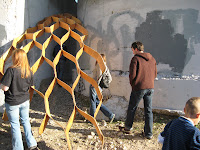Monday, April 29, 2013
Wednesday, December 10, 2008
the process cont'd



 We had a total of seven individual modules which we put together in the shop at the university and later on site on the day of the big opening. It was a completely different experience assembling the installation at the shop than on site. We needed a lot more help, for one, hanging the installation at its final destination. Putting the holding cable in place around the silo was quite a task, and we would not have been able to do it without all the extra help we got the day of the opening.
We had a total of seven individual modules which we put together in the shop at the university and later on site on the day of the big opening. It was a completely different experience assembling the installation at the shop than on site. We needed a lot more help, for one, hanging the installation at its final destination. Putting the holding cable in place around the silo was quite a task, and we would not have been able to do it without all the extra help we got the day of the opening.
the process
Monday, December 8, 2008
My piece of the puzzle


 After attempting several different infills for the cells, it was established that the material we truly wanted to use, fiberglass, was too much and out of our budget for us to finish before our deadline. We abandoned the infill and each person in the group adopted a specific piece of the whole ivy project. My piece was the "curved joiner"; a piece which curves down as well as bends to the sides as can be seen in the pictures.
After attempting several different infills for the cells, it was established that the material we truly wanted to use, fiberglass, was too much and out of our budget for us to finish before our deadline. We abandoned the infill and each person in the group adopted a specific piece of the whole ivy project. My piece was the "curved joiner"; a piece which curves down as well as bends to the sides as can be seen in the pictures.
After the midterm

 After the midterm, the studio was split into two groups: the "ivy" and the "origami" groups. In the Ivy group, I was to be in charge of infilling the cells to further support the structure. My teammate and I tried several materials, from wire mesh and casting cloth, to concrete and plexiglass, to bolts and epoxy.
After the midterm, the studio was split into two groups: the "ivy" and the "origami" groups. In the Ivy group, I was to be in charge of infilling the cells to further support the structure. My teammate and I tried several materials, from wire mesh and casting cloth, to concrete and plexiglass, to bolts and epoxy.
Sunday, October 19, 2008
making it

 Putting the components together required a bit of experimenting. I tried molding insulation foam to form one of the seats in my field of points. I also mixed a batch of concrete to make a more solid seat, which might last outside longer than a couple days. I bolted the metal bases and made the connections stronger with these metal anchors I got a Lowes. Overall, the entire seat is very sturdy and I think will be able to stand a couple days out on the site.
Putting the components together required a bit of experimenting. I tried molding insulation foam to form one of the seats in my field of points. I also mixed a batch of concrete to make a more solid seat, which might last outside longer than a couple days. I bolted the metal bases and made the connections stronger with these metal anchors I got a Lowes. Overall, the entire seat is very sturdy and I think will be able to stand a couple days out on the site.


Thursday, October 9, 2008
Bug skin
Subscribe to:
Posts (Atom)






